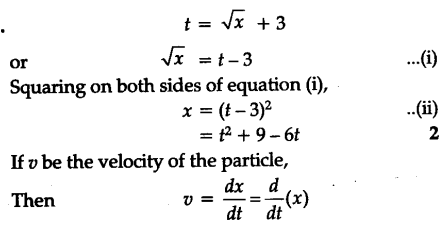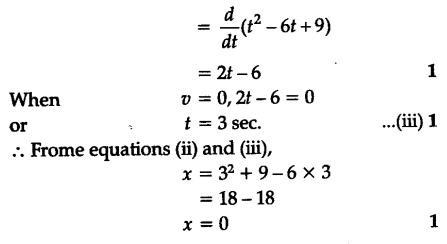Class 11 Exam > Class 11 Questions > The distance x of a particle moving in 1 dime...
Start Learning for Free
The distance x of a particle moving in 1 dimension under the action of a constant force is related to time t by equation t = root over x + 3 where x is in metres and t is in seconds . Find the displacement when it's velocity is zero.
Verified Answer
The distance x of a particle moving in 1 dimension under the action of...


 This question is part of UPSC exam. View all Class 11 courses
This question is part of UPSC exam. View all Class 11 courses
Most Upvoted Answer
The distance x of a particle moving in 1 dimension under the action of...
Understanding the Problem:
We are given a particle moving in one dimension under the action of a constant force. The distance x of the particle is related to time t by the equation t = √(x^3), where x is in meters and t is in seconds. We need to find the displacement when the velocity of the particle is zero.
Understanding the Equation:
The given equation t = √(x^3) represents the relationship between the distance x and time t. It indicates that the time taken by the particle to cover a certain distance x is equal to the square root of that distance cubed.
Finding the Velocity:
To find the displacement when the velocity is zero, we need to first find the velocity as a function of time. Since velocity is the derivative of displacement with respect to time, we can differentiate the given equation with respect to t to find the velocity function.
Differentiating both sides of the equation t = √(x^3) with respect to t:
d/dt(t) = d/dt(√(x^3))
1 = (3/2) * x^(3/2) * dx/dt
Simplifying the equation, we get:
dx/dt = 2/3 * (1 / x^(3/2))
Finding the Displacement:
To find the displacement when the velocity is zero, we need to determine the value of x when dx/dt = 0. Setting dx/dt equal to zero and solving for x:
0 = 2/3 * (1 / x^(3/2))
Multiplying both sides by 3/2 and taking the reciprocal:
0 = 1 / (x^(3/2))
0 = x^(3/2)
Since x^(3/2) = 0, we can conclude that x = 0.
Therefore, when the velocity of the particle is zero, the displacement (x) is also zero. This implies that the particle is at the origin, or its initial position.
Summary:
- The distance x of a particle moving in one dimension under the action of a constant force is related to time t by the equation t = √(x^3).
- The velocity of the particle can be found by differentiating the equation with respect to time.
- To find the displacement when the velocity is zero, we set the derivative of x with respect to t equal to zero and solve for x.
- The solution x = 0 indicates that the particle is at the origin or its initial position when the velocity is zero.
We are given a particle moving in one dimension under the action of a constant force. The distance x of the particle is related to time t by the equation t = √(x^3), where x is in meters and t is in seconds. We need to find the displacement when the velocity of the particle is zero.
Understanding the Equation:
The given equation t = √(x^3) represents the relationship between the distance x and time t. It indicates that the time taken by the particle to cover a certain distance x is equal to the square root of that distance cubed.
Finding the Velocity:
To find the displacement when the velocity is zero, we need to first find the velocity as a function of time. Since velocity is the derivative of displacement with respect to time, we can differentiate the given equation with respect to t to find the velocity function.
Differentiating both sides of the equation t = √(x^3) with respect to t:
d/dt(t) = d/dt(√(x^3))
1 = (3/2) * x^(3/2) * dx/dt
Simplifying the equation, we get:
dx/dt = 2/3 * (1 / x^(3/2))
Finding the Displacement:
To find the displacement when the velocity is zero, we need to determine the value of x when dx/dt = 0. Setting dx/dt equal to zero and solving for x:
0 = 2/3 * (1 / x^(3/2))
Multiplying both sides by 3/2 and taking the reciprocal:
0 = 1 / (x^(3/2))
0 = x^(3/2)
Since x^(3/2) = 0, we can conclude that x = 0.
Therefore, when the velocity of the particle is zero, the displacement (x) is also zero. This implies that the particle is at the origin, or its initial position.
Summary:
- The distance x of a particle moving in one dimension under the action of a constant force is related to time t by the equation t = √(x^3).
- The velocity of the particle can be found by differentiating the equation with respect to time.
- To find the displacement when the velocity is zero, we set the derivative of x with respect to t equal to zero and solve for x.
- The solution x = 0 indicates that the particle is at the origin or its initial position when the velocity is zero.
Community Answer
The distance x of a particle moving in 1 dimension under the action of...
Here first of all square root of x is defined only when x is greater than or equal to zero. Now then t must be greater than or equal to 3 second. We differentiate x w.r.t. to time then we observe that at t equal to 3 second , velocity becomes zero. And if the time less than 3 second ofcourse velocity is defined but square root of x is not defined .And hence we take motion starts from t is equal to 3 second and it is at x equal to zero and hence displacement is zero when particle is at rest momentarily.
Attention Class 11 Students!
To make sure you are not studying endlessly, EduRev has designed Class 11 study material, with Structured Courses, Videos, & Test Series. Plus get personalized analysis, doubt solving and improvement plans to achieve a great score in Class 11.

|
Explore Courses for Class 11 exam
|

|
Similar Class 11 Doubts
The distance x of a particle moving in 1 dimension under the action of a constant force is related to time t by equation t = root over x + 3 where x is in metres and t is in seconds . Find the displacement when it's velocity is zero.
Question Description
The distance x of a particle moving in 1 dimension under the action of a constant force is related to time t by equation t = root over x + 3 where x is in metres and t is in seconds . Find the displacement when it's velocity is zero. for Class 11 2024 is part of Class 11 preparation. The Question and answers have been prepared according to the Class 11 exam syllabus. Information about The distance x of a particle moving in 1 dimension under the action of a constant force is related to time t by equation t = root over x + 3 where x is in metres and t is in seconds . Find the displacement when it's velocity is zero. covers all topics & solutions for Class 11 2024 Exam. Find important definitions, questions, meanings, examples, exercises and tests below for The distance x of a particle moving in 1 dimension under the action of a constant force is related to time t by equation t = root over x + 3 where x is in metres and t is in seconds . Find the displacement when it's velocity is zero..
The distance x of a particle moving in 1 dimension under the action of a constant force is related to time t by equation t = root over x + 3 where x is in metres and t is in seconds . Find the displacement when it's velocity is zero. for Class 11 2024 is part of Class 11 preparation. The Question and answers have been prepared according to the Class 11 exam syllabus. Information about The distance x of a particle moving in 1 dimension under the action of a constant force is related to time t by equation t = root over x + 3 where x is in metres and t is in seconds . Find the displacement when it's velocity is zero. covers all topics & solutions for Class 11 2024 Exam. Find important definitions, questions, meanings, examples, exercises and tests below for The distance x of a particle moving in 1 dimension under the action of a constant force is related to time t by equation t = root over x + 3 where x is in metres and t is in seconds . Find the displacement when it's velocity is zero..
Solutions for The distance x of a particle moving in 1 dimension under the action of a constant force is related to time t by equation t = root over x + 3 where x is in metres and t is in seconds . Find the displacement when it's velocity is zero. in English & in Hindi are available as part of our courses for Class 11.
Download more important topics, notes, lectures and mock test series for Class 11 Exam by signing up for free.
Here you can find the meaning of The distance x of a particle moving in 1 dimension under the action of a constant force is related to time t by equation t = root over x + 3 where x is in metres and t is in seconds . Find the displacement when it's velocity is zero. defined & explained in the simplest way possible. Besides giving the explanation of
The distance x of a particle moving in 1 dimension under the action of a constant force is related to time t by equation t = root over x + 3 where x is in metres and t is in seconds . Find the displacement when it's velocity is zero., a detailed solution for The distance x of a particle moving in 1 dimension under the action of a constant force is related to time t by equation t = root over x + 3 where x is in metres and t is in seconds . Find the displacement when it's velocity is zero. has been provided alongside types of The distance x of a particle moving in 1 dimension under the action of a constant force is related to time t by equation t = root over x + 3 where x is in metres and t is in seconds . Find the displacement when it's velocity is zero. theory, EduRev gives you an
ample number of questions to practice The distance x of a particle moving in 1 dimension under the action of a constant force is related to time t by equation t = root over x + 3 where x is in metres and t is in seconds . Find the displacement when it's velocity is zero. tests, examples and also practice Class 11 tests.

|
Explore Courses for Class 11 exam
|

|
Suggested Free Tests
Signup for Free!
Signup to see your scores go up within 7 days! Learn & Practice with 1000+ FREE Notes, Videos & Tests.

























